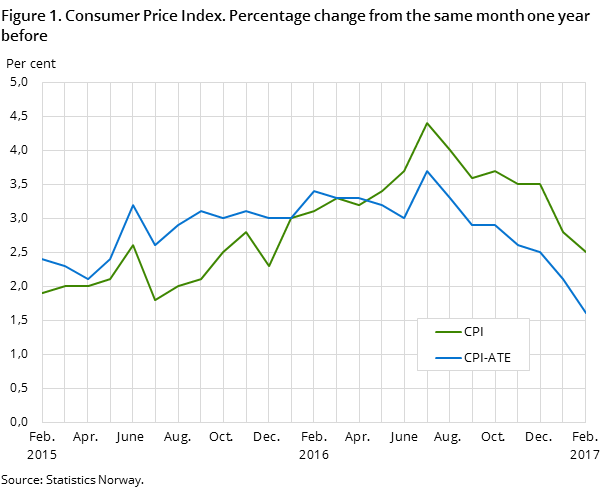Content
Published:
This is an archived release.
Furniture and food prices pull CPI up
The Consumer Price Index (CPI) rose 0.4 per cent from January 2017 to February 2017. The year-to-year growth in the CPI was 2.5 per cent in February, down 0.3 percentage points from January.
| Index | Monthly change (per cent) | 12-month rate (per cent) | |
|---|---|---|---|
| February 2017 | January 2017 - February 2017 | February 2016 - February 2017 | |
| CPI All-item index | 104.7 | 0.4 | 2.5 |
| Food and non-alcoholic beverages | 102.4 | 1.5 | 0.1 |
| Alcoholic beverages and tobacco | 105.7 | 1.3 | 1.7 |
| Clothing and footwear | 98.9 | 0.3 | -1.2 |
| Housing, water, electricity, gas and other fuels | 107.3 | 0.2 | 4.6 |
| Furnishings, household equipment and routine maintenance | 105.2 | 2.4 | 1.7 |
| Health | 103.8 | 0.4 | 2.8 |
| Transport | 103.5 | -0.7 | 2.7 |
| Communications | 105.4 | 0.1 | 2.2 |
| Recreation and culture | 106.3 | 0.0 | 3.7 |
| Education | 107.0 | 0.0 | 5.3 |
| Restaurants and hotels | 106.3 | 0.8 | 4.2 |
| Miscellaneous goods and services | 103.1 | 0.0 | 1.6 |
| CPI-ATE All-item index | 103.6 | 0.5 | 1.6 |
| CPI by delivery sector | |||
| Consumer goods | 105.2 | 0.9 | 2.8 |
| Services | 104.3 | 0.0 | 2.5 |
| Services where labor dominates | 104.9 | 0.3 | 3.1 |

The CPI-ATE rose 1.6 per cent from February 2016 to February 2017. CPI was 104.7 (2015 = 100) in February 2017, compared to 102.1 in February 2016, which corresponds to a year-to-year growth of 2.5 per cent.
Monthly change: higher prices on furniture and food
From January to February the CPI rose 0.4 per cent, mostly due to price increases on furniture and food. Prices of furniture and furnishings rose 9.5 per cent and the price increase must be seen in conjunction with the widespread sales activity in January.
After a continuous decline from August 2016 prices on food have shown price growth the last two months. Food prices rose 1.6 per cent from January to February. Airfares went down 9.4 per cent and contributed to dampening the CPI rise.
Year-to-year growth: increasing energy prices
From February 2016 to February 2017, the CPI increased by 2.5 per cent, mainly due to higher energy prices. Prices on electricity including grid rent rose 18.9 per cent the last twelve months. Fuels and lubricants also contributed to the year-to-year growth with a 14,5 per cent price increase in the same period.
A price fall of 15.9 per cent on airfares was the most important contributor in dampening the increase of the CPI.
Change in the year-to-year growth: lower growth rate in the CPI
The year-to-year growth in the CPI went down from 2.8 per cent in January to 2.5 per cent in February. The decreased growth rate was mainly caused by the development on airfares which rose 17.5 per cent from January 2016 to February 2016, while decreasing 9.4 per cent from January 2017 to February 2017. The price development on food also contributed to pulling the year-to-year growth rate down.
CPI-ATE rose 1.6 per cent in February, down 0.5 percentage points from January.
New detailed consumer classification, ECOICOPOpen and readClose
The CPI adopted Eurostat’s new detailed 5-digit consumer classification, ECOICOP in January 2016. Statistics Norway has published unofficial 5 and 6-digit COICOP indices for the consumer group Food and non-alcoholic beverages up until January 2016. As a result of a discrepancy between the unofficial and the new official ECOICOP, some previously published indices are no longer available. This results in new names for some of the published groups.
Representative goods and services in the CPI by delivery sectorOpen and readClose
Here is the detailed list of representative goods and services in the CPI by delivery sector. The list will not be automatically updated
Contact
-
Statistics Norway's Information Centre
E-mail: informasjon@ssb.no
tel.: (+47) 21 09 46 42
-
Konsumprisindeksen
E-mail: konsumprisindeksen@ssb.no
tel.: (+47) 62 88 56 34
-
Camilla Rochlenge
E-mail: camilla.rochlenge@ssb.no
tel.: (+47) 40 90 23 72
-
Kjersti Nyborg Hov
E-mail: kjersti.nyborg.hov@ssb.no
tel.: (+47) 40 90 23 63
-
Gunnar Larsson
E-mail: gunnar.larsson@ssb.no
tel.: (+47) 40 90 26 79
-
Trym Kristian Økland
E-mail: trym.okland@ssb.no
tel.: (+47) 46 81 09 15
